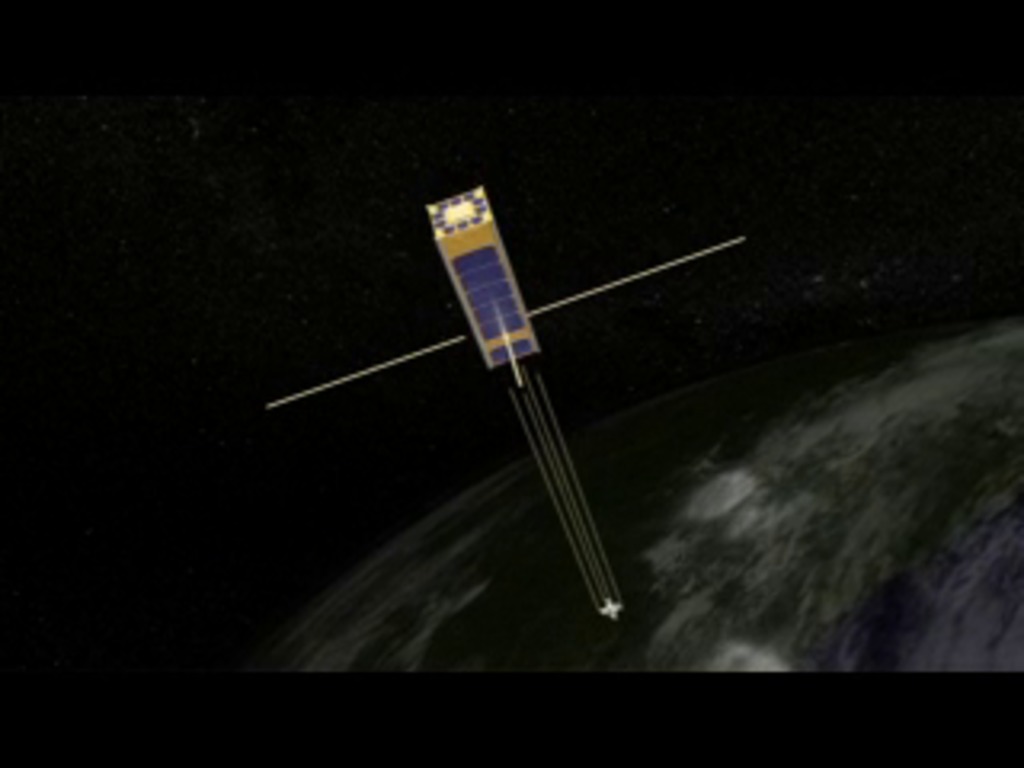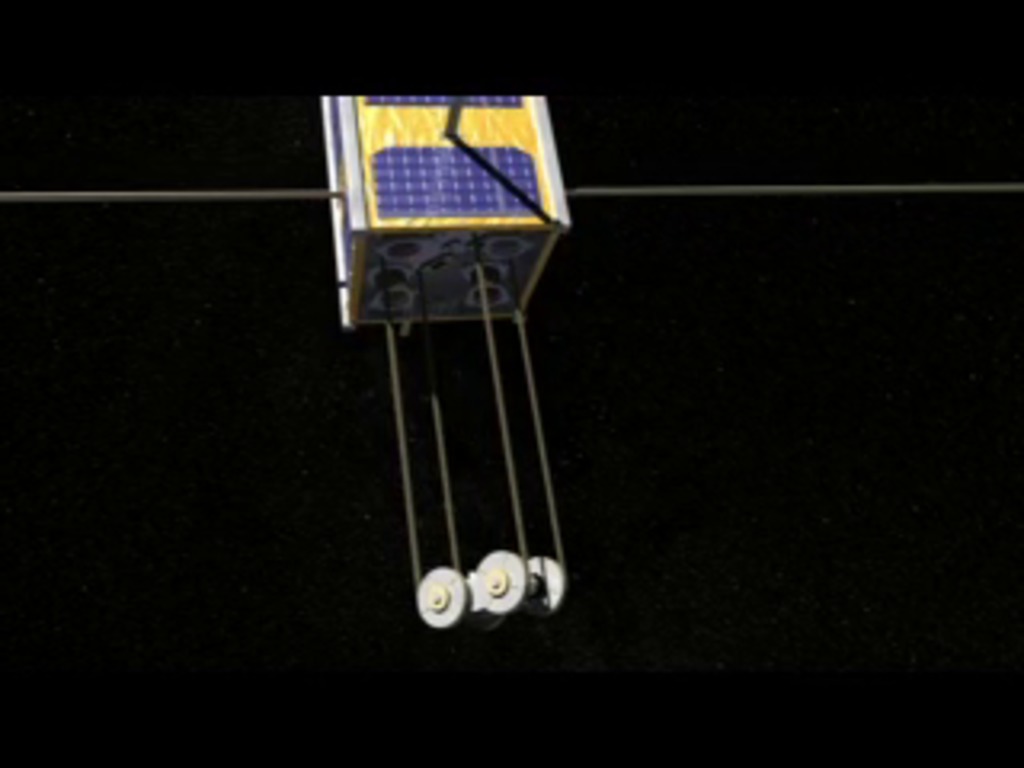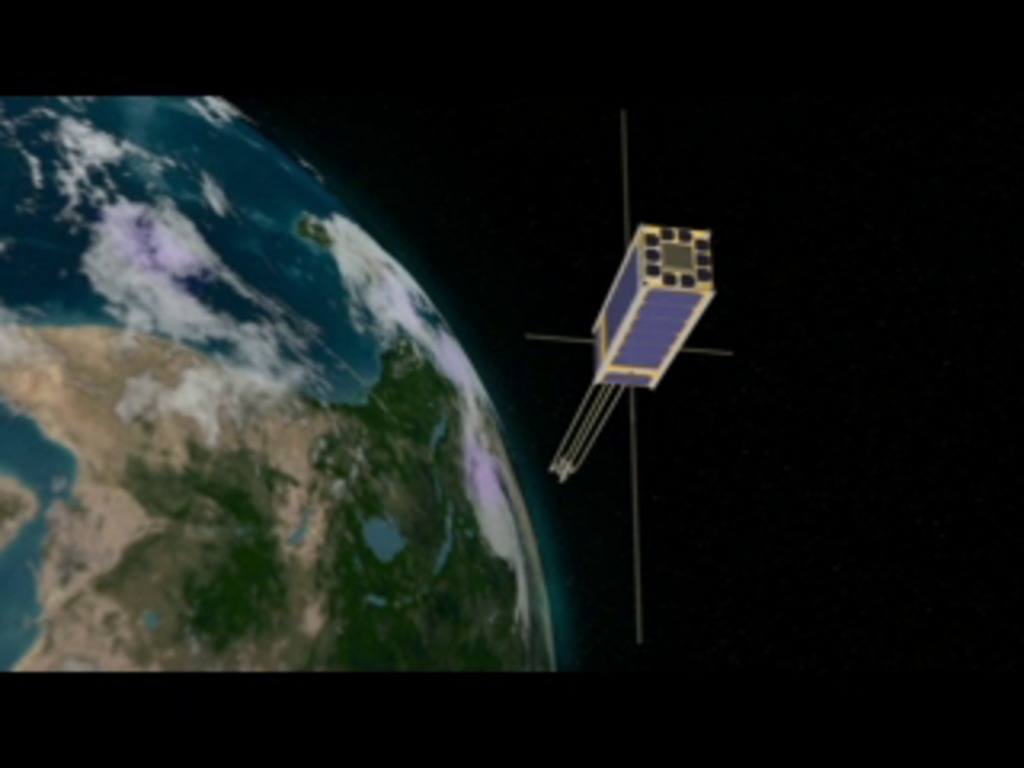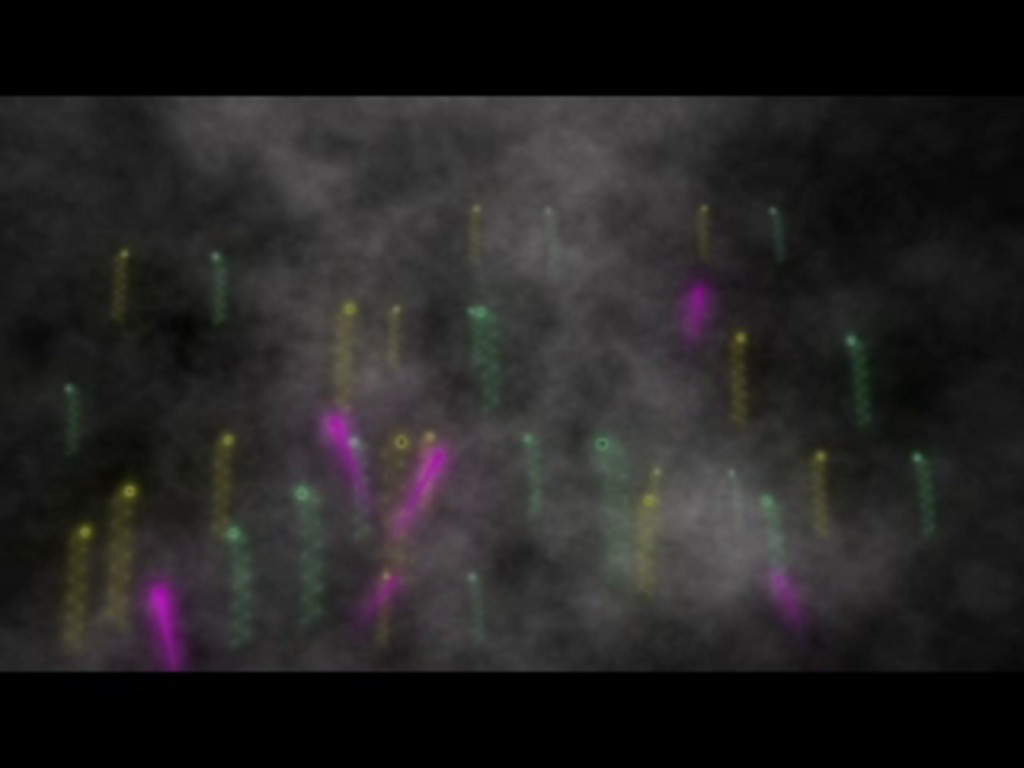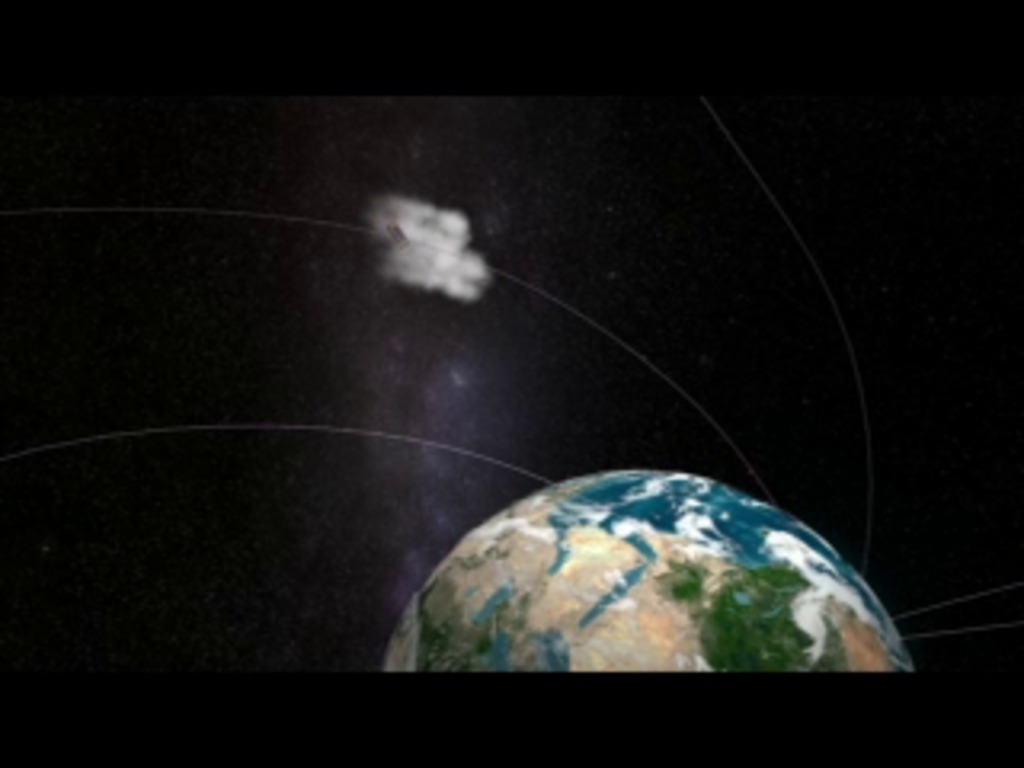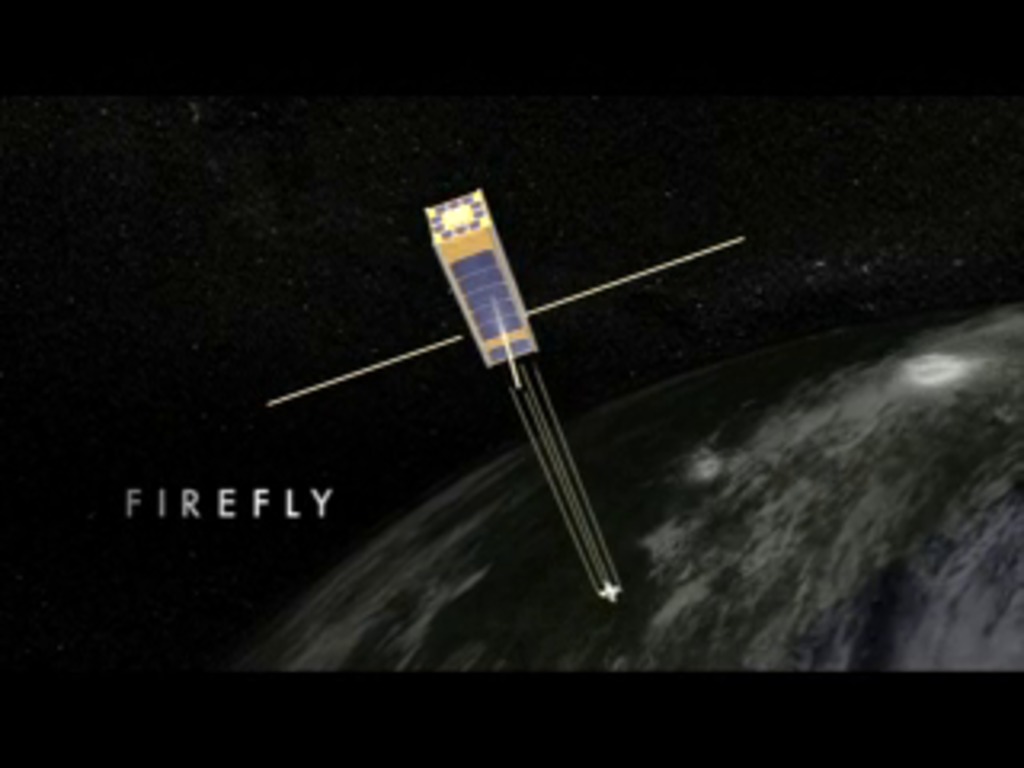Firefly
Overview
The small satellite, with a big mission, is appropriately named "Firefly". Sponsored by the National Science Foundation (NSF), the pint-sized satellite will study the most powerful natural particle accelerator on Earth, lightning, when it launches from the Marshall Islands aboard an Air Force Falcon 1E rocket vehicle next year. In particular, Firefly will focus on Terrestrial Gamma-ray Flashes (TGFs), a little understood phenomenon first discovered by NASA's Compton Gamma-Ray Observatory in the early 1990s.
Although no one knows why, it appears these flashes of gamma rays that were once thought to occur only far out in space near black holes or other high-energy cosmic phenomena are somehow linked to lightning.
Using measurements gathered by Firefly's instruments, Goddard scientist Doug Rowland and his collaborators, Universities Space Research Association in Columbia, Md., Siena College, located near Albany, N.Y., and the Hawk Institute for Space Studies in Pocomoke City, Md., hope to answer what causes these high-energy flashes. In particular, they want to find out if lightning triggers them or if they trigger lightning. Could they be responsible for some of the high-energy particles in the Van Allen radiation belts, which damage satellites? Firefly is expected to observe up to 50 lightning strokes per day, and about one large TGF every couple days.
Animations
Firefly Beauty Pass
Go to this pageThe small satellite, with a big mission, is appropriately named "Firefly." Sponsored by the National Science Foundation (NSF), the pint-sized satellite will study the most powerful natural particle accelerator on Earth - lightning - when it launches from the Marshall Islands aboard an Air Force Falcon 1E rocket vehicle next year. In particular, Firefly will focus on Terrestrial Gamma-ray Flashes (TGFs), a little understood phenomenon first discovered by NASA's Compton Gamma-Ray Observatory in the early 1990s.Although no one knows why, it appears these flashes of gamma rays that were once thought to occur only far out in space near black holes or other high-energy cosmic phenomena are somehow linked to lightning.Using measurements gathered by Firefly's instruments, Goddard scientist Doug Rowland and his collaborators - Universities Space Research Association in Columbia, Md., Siena College, located near Albany, N.Y., and the Hawk Institute for Space Studies in Pocomoke City, Md. - hope to answer what causes these high-energy flashes. In particular, they want to find out if lightning triggers them or if they trigger lightning. Could they be responsible for some of the high-energy particles in the Van Allen radiation belts, which damage satellites? Firefly is expected to observe up to 50 lightning strokes per day, and about one large TGF every couple days. ||
Firefly Deployment
Go to this pageThe small satellite, with a big mission, is appropriately named "Firefly." Sponsored by the National Science Foundation (NSF), the pint-sized satellite will study the most powerful natural particle accelerator on Earth - lightning - when it launches from the Marshall Islands aboard an Air Force Falcon 1E rocket vehicle next year. In particular, Firefly will focus on Terrestrial Gamma-ray Flashes (TGFs), a little understood phenomenon first discovered by NASA's Compton Gamma-Ray Observatory in the early 1990s.Although no one knows why, it appears these flashes of gamma rays that were once thought to occur only far out in space near black holes or other high-energy cosmic phenomena are somehow linked to lightning.fly's instruments, Goddard scientist Doug Rowland and his collaborators - Universities Space Research Association in Columbia, Md., Siena College, located near Albany, N.Y., and the Hawk Institute for Space Studies in Pocomoke City, Md. - hope to answer what causes these high-energy flashes. In particular, they want to find out if lightning triggers them or if they trigger lightning. Could they be responsible for some of the high-energy particles in the Van Allen radiation belts, which damage satellites? Firefly is expected to observe up to 50 lightning strokes per day, and about one large TGF every couple days. ||
Firefly in Orbit
Go to this pageThe small satellite, with a big mission, is appropriately named "Firefly." Sponsored by the National Science Foundation (NSF), the pint-sized satellite will study the most powerful natural particle accelerator on Earth - lightning - when it launches from the Marshall Islands aboard an Air Force Falcon 1E rocket vehicle next year. In particular, Firefly will focus on Terrestrial Gamma-ray Flashes (TGFs), a little understood phenomenon first discovered by NASA's Compton Gamma-Ray Observatory in the early 1990s.Although no one knows why, it appears these flashes of gamma rays that were once thought to occur only far out in space near black holes or other high-energy cosmic phenomena are somehow linked to lightning.fly's instruments, Goddard scientist Doug Rowland and his collaborators - Universities Space Research Association in Columbia, Md., Siena College, located near Albany, N.Y., and the Hawk Institute for Space Studies in Pocomoke City, Md. - hope to answer what causes these high-energy flashes. In particular, they want to find out if lightning triggers them or if they trigger lightning. Could they be responsible for some of the high-energy particles in the Van Allen radiation belts, which damage satellites? Firefly is expected to observe up to 50 lightning strokes per day, and about one large TGF every couple days. ||
Radiation Generated in Electric Fields Over Thunderstorms
Go to this pageThe small satellite, with a big mission, is appropriately named "Firefly." Sponsored by the National Science Foundation (NSF), the pint-sized satellite will study the most powerful natural particle accelerator on Earth - lightning - when it launches from the Marshall Islands aboard an Air Force Falcon 1E rocket vehicle next year. In particular, Firefly will focus on Terrestrial Gamma-ray Flashes (TGFs), a little understood phenomenon first discovered by NASA's Compton Gamma-Ray Observatory in the early 1990s.Although no one knows why, it appears these flashes of gamma rays that were once thought to occur only far out in space near black holes or other high-energy cosmic phenomena are somehow linked to lightning.fly's instruments, Goddard scientist Doug Rowland and his collaborators - Universities Space Research Association in Columbia, Md., Siena College, located near Albany, N.Y., and the Hawk Institute for Space Studies in Pocomoke City, Md. - hope to answer what causes these high-energy flashes. In particular, they want to find out if lightning triggers them or if they trigger lightning. Could they be responsible for some of the high-energy particles in the Van Allen radiation belts, which damage satellites? Firefly is expected to observe up to 50 lightning strokes per day, and about one large TGF every couple days. ||
Firefly Sees Electrons Populate the Radiation Belts
Go to this pageThe small satellite, with a big mission, is appropriately named "Firefly." Sponsored by the National Science Foundation (NSF), the pint-sized satellite will study the most powerful natural particle accelerator on Earth - lightning - when it launches from the Marshall Islands aboard an Air Force Falcon 1E rocket vehicle next year. In particular, Firefly will focus on Terrestrial Gamma-ray Flashes (TGFs), a little understood phenomenon first discovered by NASA's Compton Gamma-Ray Observatory in the early 1990s.Although no one knows why, it appears these flashes of gamma rays that were once thought to occur only far out in space near black holes or other high-energy cosmic phenomena are somehow linked to lightning.fly's instruments, Goddard scientist Doug Rowland and his collaborators - Universities Space Research Association in Columbia, Md., Siena College, located near Albany, N.Y., and the Hawk Institute for Space Studies in Pocomoke City, Md. - hope to answer what causes these high-energy flashes. In particular, they want to find out if lightning triggers them or if they trigger lightning. Could they be responsible for some of the high-energy particles in the Van Allen radiation belts, which damage satellites? Firefly is expected to observe up to 50 lightning strokes per day, and about one large TGF every couple days. ||
Edited Features
NASA-led Firefly Mission to Study Lightning
Go to this pageSomewhere on Earth, there's always a lightning flash. The globe experiences lightning some 50 times a second, yet the details of what initiates this common occurrence and what effects it has on the atmosphere – lightning may be linked to incredibly powerful and energetic bursts called terrestrial gamma ray flashes, or TGFs — remains a mystery. In mid-November, a football-sized mission called Firefly, which is funded by the National Science Foundation, will launch into space to study lightning and these gamma ray flashes from above. The NSF CubeSat program represents a low cost access to space approach to performing high-quality, highly targeted science on a smaller budget than is typical of more comprehensive satellite projects, which have price tags starting at $100 million. The CubeSat Firefly, by focusing its science goals, will carry out its mission in a much smaller package and at a considerably lower cost. The Firefly mission also emphasizes student involvement as part of the ongoing effort to train the next generation of scientists and engineers. Students at Siena College, in Loudonville, N.Y., and the University of Maryland Eastern Shore, in Princess Anne, Md., were involved in all phases of the Firefly mission. The window for Firefly launch opens on Nov. 19, 2013, and it is scheduled to launch with 27 other cubesat missions, as well as a NASA experiment called the Total solar irradiance Calibration Transfer Experiment, or TCTE, which will continue measurements from space of the total energy output of the sun. ||
